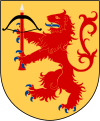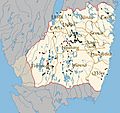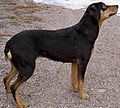Småland facts for kids
Quick facts for kids
Småland
|
||
|---|---|---|
|
||
 |
||
| Country | Sweden | |
| Land | Götaland | |
| Counties | Kronoberg County Kalmar County Jönköping County Halland County Östergötland County |
|
| Area | ||
| • Total | 29,400 km2 (11,400 sq mi) | |
| Population
(31 December 2016)
|
||
| • Total | 754,535 | |
| • Density | 25.66/km2 (66.47/sq mi) | |
| Ethnicity | ||
| • Language | Swedish | |
| • Dialect | Småländska | |
| • Demonym | Smålänning | |
| Culture | ||
| • Flower | Twinflower | |
| • Animal | Otter | |
| • Bird | Song thrush | |
| Time zone | UTC+1 (CET) | |
| • Summer (DST) | UTC+2 (CEST) | |
| Postal codes |
33000–34999, 35000–36999, 38000–39999, 55000–57999, 59000–59999 (shared with Östergötland)
|
|
| Area codes | 0370-0372 0433 0459 0470–0478 0480–0493 |
|
Småland is a historical province in southern Sweden. It's known for its beautiful nature and rich history. The name Småland actually means Small lands. This is because it was once made up of many smaller areas that joined together.
Småland shares its borders with several other provinces. These include Blekinge, Scania, Halland, Västergötland, and Östergötland. It also lies near the island of Öland in the Baltic Sea. The highest point in Småland is Tomtabacken, which is 377 meters (about 1,237 feet) tall.
Many famous people come from Småland. One of the most well-known is the Swedish writer Astrid Lindgren. She wrote popular children's books like Pippi Longstocking. Many of her stories are set right here in Småland.
Contents
Geography and Nature in Småland
Småland is a large area with diverse landscapes. It covers about 29,400 square kilometers (11,350 square miles). This makes it one of Sweden's bigger provinces.
Forests and Lakes
Småland is famous for its many forests and lakes. The forests are mostly made up of pine and spruce trees. They provide a home for many animals. The province has thousands of lakes, big and small. These lakes are great for fishing and other water activities.
Highest Point: Tomtabacken
The highest point in Småland is Tomtabacken. It stands at 377 meters above sea level. This makes it a significant landmark in the region. From its top, you can see far across the landscape.
History of Småland
Småland has a long and interesting history. It was first settled by people thousands of years ago. The name "Small lands" tells us about its past.
Early Settlements
In ancient times, Småland was not one single area. It was a collection of many small, independent "lands." Each had its own local rules and customs. Over time, these small lands slowly came together. This formed the larger province we know today.
Important Historical Sites
You can find many historical sites in Småland. These include old churches and ancient runestones. Runestones are large stones with carvings. They tell stories from the Viking Age and early medieval times. Some runestones in Småland even mention long voyages.
Culture and Traditions
Småland has a unique culture. It is known for its hardworking people and strong traditions.
Småland Dialect
People in Småland speak a special dialect of Swedish. It is called Småländska. This dialect has its own unique sounds and words.
Local Animals and Plants
Every province in Sweden has its own special symbols. For Småland, the official flower is the Twinflower. The official animal is the Otter. The official bird is the Song thrush. These symbols represent the nature of Småland.
Traditional Crafts
Småland is also known for its traditional crafts. One famous craft is making Windsor chairs. These chairs are produced in large numbers here. You can also see many traditional red farmhouses. They often have white corners. This is a common style in Småland.
Images for kids
-
The small lands of Småland. The black and red spots indicate runestones. The red spots indicate runestones telling of long voyages.
See also
 In Spanish: Småland para niños
In Spanish: Småland para niños











